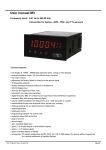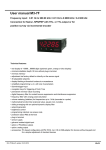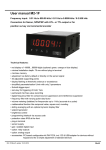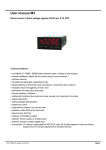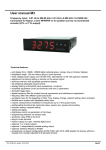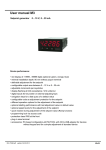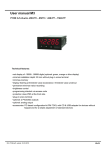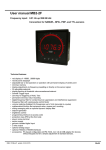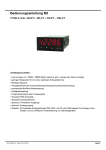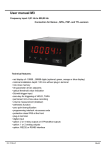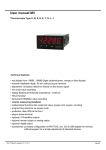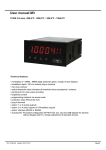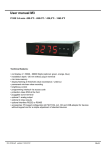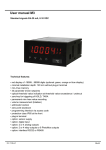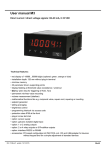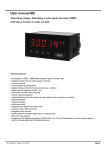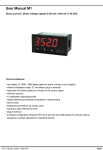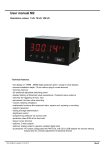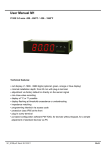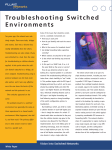Download User manual M3
Transcript
User manual M3 Frequency input: 0,01 Hz to 999,99 kHz Connection for Namur-, NPN-, PNP- and TTL-sensors Technical features: • red display of -19999…99999 digits (optional: green, orange or blue display) • minimal installation depth: 90 mm without plug-in terminal • min-/max memory • adjustment via factory default or directly on the sensor signal • 30 adjustable setpoints • display flashing at threshold undercut or exceedance • Schmitt-trigger-input • zero-key for triggering of Hold, Tara • permanent min-/max-value recording • digital frequency filter for contact bounce suppression and interference suppresion • frequency filter with varying pulse-duty factor • volume metering (totaliser) for frequencies up to 1 kHz (accurate to a pulse) • mathematical function like reciprocal value, square root, rounding • sliding averaging with an optional dynamic display filter • setpoint generator • brightness control • programming interlock via access code • protection class IP65 at the front • plug-in terminal • option: sensor supply • option: galv. insulated digital input • option: PhotoMos-outputs • option: analog output • accessories: PC-based configuration-kit PM-TOOL incl. CD & USB.adapter for devices without keypad and for a simple adjustment of standard devices M3_7FGB.pdf updated: 12.06.2012 48x24 Identification STANDARD TYPES ORDER NUMBER Frequency Housing size: 48x24 mm M3-7FR5A.0007.S70AD M3-7FR5A.0007.770AD Options – breakdown of order code: M 3- 7 F R 5 A. 0 0 0 7. 7 7 2 A D Standard type M-Line Dimension D physical unit Installation depth incl. plug-in terminal 109 mm 3 Version A A Housing size B48xH24xD90 mm 7 Setpoints 0 no setpoints Display type Frequency F 2 2 PhotoMos-outputs Protection class 1 without keypad, Display colour Blue B operation on the back Green Red G R 7 IP65 / plug-in terminal Yellow Y Number of digits 5-digit Voltage supply 7 24 VDC, galv. insulated S 100-240 VAC 5 Measuring input 7 0.01 Hz - 999.99 kHz Digit height 10 mm A Analog output 0 none Digital input none 0 1 digital input I X 0-10 VDC, 0/4-20 mA Sensor supply 0 none 3 24 VDC / 50 mA incl. digital input K 24 VDC / 50 mA incl. digital input and pulse output (10 kHz) Please state physical unit by order, e.g. m/min. Contents 1. Brief descirption 2 2. Assembly 3 3. Electrical connection 4 4. Function description and operation 6 4.1. Programming software PM-TOOL 7 Setting up the device 8 5.1. Switching on 8 5.2. Standard parameterisation (flat operation level) 8 5. Value assignment for the triggering of the signal input 5.3. Programming interlock „RUN“ 12 Activation/Deactivation of the programming interlock or change into professional or flat operation level 5.4. Extended parametersation (professional operation level) 5.4.1. Signal input parameters „INP“ 13 13 Value assignment for the triggering of the signal input incl. linearisation 5.4.2. General device parameters „FCT“ 17 Superior device functions like Hold, Tara, min/max permanent, setpoint value function / nominal value function, averaging, brightness control, as well as the control of the digital input and keyboard layout 5.4.3. Safety parameters „COD“ 21 Assignment of user and master code to lock or to receive access to defined parameter such as analog output and alarms, etc. 5.4.4. Analog output parameters „Out“ 22 Analog output functions 5.4.5. Relay functions „rel“ 24 Parameter for setpoint definition 5.4.6. Alarm parameters „AL1…AL4“ 26 Actuator and dependencies of the alarms 5.4.7. Totaliser (Volume metering) „tot“ 28 Parameter for calculation of the sum function 6. Reset to factory settings 29 Reset parameters onto the delivery state 7. Alarms / Relays 30 Functional principle of the switching outputs 8. Programmer examples 31 Sample applications such as e.g. calculation of the input frequency or the adjustment at unknown rotation speed 9. Technical data 33 10. Safety advices 35 11. Error elimination 36 1 1. Brief description 1. Brief description The panel meter instrument M3-7F is a 5-digit device for pulse signals, respectivley 2- and 3-wire sensors. The configuration happens via three keys at the front. The integrated programming interlock prevents unrequested changes of parameters and can be unlocked again with an individual code. Optional the following functions are available: a supply for the sensor, a digital input for triggering of Hold (Tara), one analog output or switching outputs for further evaluating in the unit. The electrical connection is done via plug-in terminals on the back side. Selectable functions like e.g. the recall of the min/max-value, an averaging of the measuring signals, a nominal presetting or setpoint presetting, digital frequency filter for contact bounce suppression and disturbance suppression with adjustable key relation, a direct threshold value regulation during operation mode and further measuring setpoints for linearisation, complete the modern device concept. 2 2. Assembly 2. Assembly Please read the Safety advices on page 35 before installation and keep this user manual for future reference. 3,0 24,0 Se alin g 48 ,0 tion alla t s In Gap for physical dimension 1. 2. 3. ls ina rm e t m n 0m ctio 12 ne n o l. c inc h t p de After removing the fixing elements, insert the device. Check the seal to make sure it fits securely. Click the fixing elements back into place and tighten the clamping screws by hand. Then use a screwdriver to tighten them another half a turn. CAUTION! The torque should not exceed 0.1 Nm! Change signs of the physical unit before assembly via a channel at the side of the front! The change can only be done from the outside before assembly! 3 3. Electrical connection 3. Electrical connection 4 3. Electrical connection M3-devices Below you find some connection examples with practical applications: 5 4. Function- and operation description 4. Function- and operation description Operation The operation is divided into three different levels. Menu level (delivery status) This level is for the standard settings of the device. Only menu items which are sufficent to set the device into operation are displayed. To get into the professional level, run through the menu level and parameterise “prof“ under menu item RUN. Menu group level (complete function volume) Suited for complex applications as e.g. linkage of alarms, setpoint treatment, totaliser function etc. In this level function groups which allow an extended parameterisation of the standard settings are availabe. To leave the menu group level, run through this level and parameterise „uloc„ under menu item RUN. Parameterisation level: Parameter deposited in the menu item can here be parameterised. Functions, that can be changed or adjusted, are always signalised by a flashing of the display. Settings that are made in the parameterisation level are confirmed with [P] and thus safed. By pressing the „zero-key“ it leads to a break-off of the value input and to a change into the menu level. All adjustments are safed automatically by the device and changes into operating mode, if no further key operation is done within the next 10 seconds. Level Key Description Change to parameterisation level and deposited values. Menu level Keys for up and down navigation in the menu level. Change into operation mode. To confirm the changes made at the parameterization level. Parameterisation level Adjustment of the value / the setting. Change into menu level or break-off in value input. Change to menu level. Menu group level Keys for up and down navigation in the menu group level. Change into operation mode or back into menu level. 6 4. Function and operation description Function chart: 4.1. Parameterisation software PM-TOOL: Part of the PM-TOOL are the software on CD and an USB-cable with device adapter. The connection is done via a 4-pole micromatch-plug on the back side of the device, to the PC-side the connection ist done via an USB plug. System requirements: PC incl. USB interface Software: Windows XP, Windows VISTA With this tool the device configuration can be generated, omitted and safed on the PC. The parameters can be changed via the easy to handle program surface, whereat the operating mode and the possible selection options can be preset by the program. 7 5. Setting up the device 5. Setting up the device 5.1. Switching-on Once the installation is complete, you can start the device by applying the voltage supply. Before, check once again that all electrical connections are correct. Starting sequence For 1 second during the switching-on process, the segment test (8 8 8 8 8) is displayed, followed by an indication of the software type and, after that, also for 1 second, the software version. After the starting sequence, the device switches to operation/display mode. 5.2. Standard parameterisation: (flat operation level) To parameterize the display, press the [P] key in operating mode for 1 second. The display then changes to the menu level with the first menu item TYPE. Menu level Parameterisation level Selection of the input signal, TYPE: Default: frequ If the scaling of the device is done via SEnS.F (Sensor calibration), the frequency range needs to be preset under rAnGE and is adjusted by application of the final value /initial value. If FrEqU (Factory calibration) is preferred, the final value needs to be entered under End and the final frequency needs to be entered under EndA. Under OFFS the initial value needs to be entered and under OFFSA the initial frequency. There is no application of the measuring signal. Confirm the selection with [P] and the display switches back to menu level. Setting end value of the measuring range, END: Default: 100e3 9.9999 Hz 99.999 Hz 99.999 kHz 999.99 kHz 999.99 Hz 9.9999 kHz Choose between six different frequency ranges. Confirm the selection with [P] and the display switches back to menu level. Setting the final value of the measuring range, END: Default: 10000 Set the final value from the smallest to the highest digit with [▲] [▼] and confirm each digit with [P]. A minus sign can only be parametrized on the highest value digit. After the last digit, the display switches back to the menu level. If Sens was selected as input option, you can only select between noca and cal. With noca, only the previously set display value is taken over, and with cal, the device takes over both the display value and the analogue input value. 8 5. Setting up the device Menu level Parameterisation level Setting the start/offset value of the measuring range, offs: Default: 0 Enter the start/offset value from the smallest to the highest digit [▲] [▼] and confirm each digit with [P]. After the last digit the display switches back to the menu level. If Sens.F was selected as the input option, you can only select between noca and cal. With noca, only the previously set display value is taken over, and with cal, the device takes over both the display value and the analogue input value. Setting the decimal point, dot: Default: 0 The decimal point on the display can be moved with [▲] [▼] and confirmed with [P]. The display then switches back to the menu level again. Setting up the display time, SEC: Default: 1.0 then The display time is set with [▲] [▼]. The display moves up in increments of 0.1 sec up to 1 sec and in increments of 1.0 sec up to 10.0 sec. Confirm the selection by pressing the [P] button. The display then switches back to the menu level again. Rescaling the measuring input values, EndA: Default: 10000 With this function, you can rescale the input value of e.g. 8.000 Hz (works setting) without applying a measuring signal. If sensor calibration has been selected, these parameters are not available. Rescaling the measuring input values, OFFA: Default: 0 With this function, you can rescale the input value of e.g. 100 Hz (works setting) without applying a measuring signal. If sensor calibration has been selected, these parameters are not available. 9 5. Setting up the device Menu level Parameterisation level Setting of the pulse delay, dELAY: Default: 0 With the impulse delay of 0 – 250 s (max), frequencies can be collected, which are even smaller than by the predetermined measuring time of the device. If e.g. a delay of 250 seconds is set, this means that the device waits up to 250 seconds for an edge, before it assumes a 0 Hz-frequency. Thus frequencies up to 0.004 Hz can be collected. Adjustment of the optimum digital frequency filter, fi.frq: Default: NO If the optional filter is not activated by the adjustment „No“, frequences are ignored by the adjusted frequency filter. Act on the assumption that the pulse-duty factor is 1:1. Accordingly the minimal pulse duration is derived from the half of the time of oscillation. Use a filter of 10 Hz or 20 Hz for contact bounce suppression. Selection of analog output, Out.rA: Default: 4-20 Three output signals are available: 0-10 VDC, 0-20 mA and 4-20 mA, with this function, the demanded signal is selected. Setting up the final value of the analog output, Out.En: Default: 10000 The final value is adjusted from the smallest digit to the highest digit with [▲] [▼] and digit by digit confirmed with [P]. A minus sign can only be parameterised on the highest digit. After the last digit, the device changes back into menu level. Setting up the initial value of the analog output, Out.OF: Default: 00000 The final value is adjusted from the smallest digit to the highest digit with [▲] [▼] and digit by digit confirmed with [P]. A minus sign can only be parametrised on the highest digit. After the last digit, the device changes back into menu level. 10 5. Setting up the device Menu level Parameterisation level Threshold values / limit values, LI-1: Default: 2000 For both limit values, two different values can be parameterized. With this, the parameters for each limit value are called up one after another. Hysteresis for limit values, HY-1: Default: 00000 For all limit values exists a hysteresis function, that reacts according to the settings (threshold exceedance / threshold undercut). Function if display falls below / exceeds limit value, FU-1: Default: high The limit value undercut can be selected with Louu (LOW = lower exceedance can be selected with high (HIGH = upper limit value). switching threshold of 100 and occupied with function „high“, the reaching the threshold. If the limit value is allocated to „Low“, an undercut of the threshold. See page 29. limit value) and limit value If e.g. limit value 1 is on a alarm will be activated by alarm will be activated by Threshold values / Limits, LI-2: Default: 3000 This value defines the threshold, that activates/deactivates an alarm. Hysteresis for limit values, HY-2: Default: 00000 The delayed reaction of the alarm is the difference to the threshold value, which is defined by the hysteresis. Function for threshold value undercut /exceedance, Fu-2: Default: high A limit value undercut is selected with Louu (for LOW = lower limit value), a limit value exceedance with High (for HIGH = higher limit value). If e.g. limit value 1 is on a threshold level of 100 and allocated with function High, an alarm is activated by reaching of the threshold level. If the threshold value was allocated to Low, an alarm will be activated by undercutting the threshold value, as long as the hysteresis is zero. 11 5. Setting up the device Menu level Parameterisation level User code (4-digit number-combination, free available), U.CodE: Default: 0000 If this code is set (>0000), all parameters are locked, if LOC has been selected before under menu item run. By pushing [P] during operation mode for approx. 3 seconds, Code appears in the display. To get to the unlocked reduced parameter, the user needs to enter the preset U.Code. This code has to be entered before each parametrisation, until the A.Code (Master code) unlocks all parameters again. Master code (4-digit number-combination free available), A.CodE: Default: 1234 With this code, all parameters can be unlocked, if LOC has been activated before under menu item run. By pushing [P] during operation mode for approx. 3 seconds, Code appears in the display. The user can now reach all parameters by entering A.codE. Leaving the parametrisation, under menu item run, the user can unlock them permanently by choosing ULOC or ProF. So, there is no need for anew code entering, even by pushing [P] during operation mode again. 5.3. Programming interlock „run“ Activation / deactivation of the programming lock or completion of the standard parameterization with change into menu group level (complete function range), run: Default: uloc With the navigation keys [▲] [▼], you can choose between the deactivated key lock Uloc (works setting) and the activated key lock Loc, or the menu group level ProF. Confirm the selection with [P]. After this, the display confirms the settings with "- - - - -", and automatically switches to operating mode. If Loc was selected, the keyboard is locked. To get back into the menu level, press [P] for 3 seconds in operating mode. Now enter the CODE (works setting 1 2 3 4) that appears using [▲] [▼] plus [P] to unlock the keyboard. FAIL appears if the input is wrong. To parameterise further functions ProF needs to be set. The device confirms this setting with „- - - - - „ and changes automatically in operation mode. By pressing [P] for approx. 3 seconds in operation mode, the first menu group InP is shown in the display and thus confirms the change into the extended parameterisation. It stays activated as long as ULOC is entered in menu group RUN , thus the display is set back in standard parameterisation again. 12 5. Setting up the device 5.4. Extended parametrisation (Professional operation level) 5.4.1. Signal input parameters Menu group level Menu level Menu level Parameterisation level Selection of the input signal, TYPE: Default: frequ If the scaling of the device is done via SEnS.F (Sensor calibration), the frequency range needs to be preset under rAnGE and is adjusted by application of the final value /initial value. If FrEqU (Factory calibration) is preferred, the final value needs to be entered under End and the final frequency needs to be entered under EndA. Under OFFS the initial value needs to be entered and under OFFSA the initial frequency. There is no application of the measuring signal. Confirm the selection with [P] and the display switches back to menu level. Setting the end value of the measuring range, END: Default: 100e3 9.9999 Hz 99.999 Hz 99.999 kHz 999.99 kHz 999.99 Hz 9.9999 kHz Choose between six different frequency ranges. Confirm the selection with [P] and the display switches back to menu level. Setting the final value of the measuring range, END: Default: 10000 Set the final value from the smallest to the largest digit with [▲] [▼] and confirm each digit with [P]. A minus sign can only be parameterized on the highest value digit. After the last digit, the display switches back to the menu level. If Sens was selected as input option, you can only select between noca and cal. With noca, only the previously set display value is taken over, and with cal, the device takes over both the display value and the analogue input value. 13 5. Setting up the device Menu level Parameterisation level Setting the start/offset value of the measuring range, offs: Default: 0 Enter the start/offset value from the smallest to the highest digit [▲] [▼] and confirm each digit with [P]. After the last digit the display switches back to the menu level. If Sens.F was selected as the input option, you can only select between noca and cal. With noca, only the previously set display value is taken over, and with cal, the device takes over both the display value and the analogue input value. Setting the decimal point, dot: Default: 0 The decimal point on the display can be moved with [▲] [▼] and confirmed with [P]. The display then switches back to the menu level again. Setting up the display time, SEC: Default: 1.0 then The display time is set with [▲] [▼]. The display moves up in increments of 0.1 sec up to 1 sec and in increments of 1.0 sec up to 10.0 sec. Confirm the selection by pressing the [P] button. The display then switches back to the menu level again. Rescaling the measuring input values, EndA: Default: 10000 With this function, you can rescale the input value of e.g. 8.000 Hz (works setting) without applying a measuring signal. If sensor calibration has been selected, these parameters are not available. Rescaling the measuring input values, OFFA: Default: 0 With this function, you can rescale the input value of e.g. 100 Hz (works setting) without applying a measuring signal. If sensor calibration has been selected, these parameters are not available. 14 5. Setting up the device Menu level Parameterisation level Setting up the pulse delay, dELAY: Default: 0 With the pulse delay of 0 – 250 s (max), frequencies can be collected, which are even smaller than by the predetermined measuring time of the device. If e.g. a delay of 250 seconds is set, this means that the device waits up to 250 seconds for an edge, before it assumes a 0 Hzfrequency. Thus frequencies up to 0.004 Hz can be collected. Adjustment of the optimum digital frequency filter, fi.frq: Default: NO If the optional filter is not activated by the adjustment „No“, frequences are ignored by the adjusted frequency filter. Act on the assumption that the pulse-duty factor is 1:1. Accordingly the minimal pulse duration is derived from the half of the time of oscillation. Use a filter of 10 Hz or 20 Hz for contact bounce suppression. Adjustment of the pulse-duty factor at activated digital filter, fi.rat: Default: i-i Adjustment of the desired pulse-duty factor for pulse duration and pulse interruption. Like this, a special pulse behaviour can be adjusted. Setting up the tare/offset value, tArA: Default: 0 The given value is added to the linerarized value. In this way, the characteristic line can be shifted by the selected amount. Number of additional setpoints, SPCt: Default: 00 30 additional setpoints can be defined to the initial- and final value, so linear sensor values are not linearised. Only activated setpoint parameters are displayed. 15 5. Setting up the device Menu level Parameterisation level Display values for setpoints, dIS.01 … dIS.30: Under this parameter setpoints are defined according to their value. At the sensor calibration, like at Final value/Offset, one is asked at the end if a calibration shall be activated. Analog values for setpoints, InP.01 … InP.30: These setpoints are displayed at works setting (4-20 mA) only. Here, demanded analog values can be choosen freely. The input of steadily rising analog values needs to be done selfcontained. Display underflow, dI.Und: Default: -19999 With this function the device undercut (_ _ _ _ _) can be defined on a definite value. Display overflow, dI.OUE: Default: 99999 With this function the display overflow ( _____ ) can be defined on a definite value. Input variable of process value, SIG.in: Default: a.meas This parameter controls the device via the analog input signals a.meas = Sens.f repectively fre9u or via the digital signals of the interface M.bus = RS232/RS485 (Modbus protocol). Confirm the selction with [P] and the device changes back into menu level. Back to menu group level, rEt: With [P] the selection is confirmed and the device changes into menu group level „–INP-“. 16 5. Setting up the device 5.4.2. General device parameters Menu group level Menu level Menu level Parameterisation level Display time, DISEC: Default: 01.0 then The display is set up with [▲] [▼]. Thereby on switches until 1 second in 0.1 steps and until 10.0 seconds in 1.0-steps. With [P] the selection is confirmed and the device changes into menu level. Rounding of display values, round: Default: 00001 This function is for instable display values, where the display value is changed in 1-, 5-, 10- or 50-steps. This does not affect the resolution of the optional outputs. With [P] the selection is confirmed and the device changes into menu level. Arithmetic, ArItH: Default: no Root extraction Reciprocal Square With this function the calculated value, not the measuring value, is shown in the display. With no , no calulation is deposited. With [P] the selection is confirmed and the device changes into menu level. Sliding average determination, AVG: Default: 10 Here, the number of the meterings that need to be averaged is preset. The time of averaging results of the product of measuring time SEC and the averaged metering AVG. With the selection of AVG in the menu level DISPL, the result will be shown in the display and evaluated via the alarms. 17 5. Setting up the device Menu level Parameterisation level Dynamic for the sliding average determination, step: Default: no With step the sliding average determination can be adjusted dynamically. If 6pro or 12pro is selected, a frequency value with a variance of 6% or 12% of the current display value is taken over directly for the sliding averaging. The display appears to be more dynamic at a fast frequency change, without appearing disturbed by a slightly unsteady frequency. Zero point slowdown, ZErO: Default: 00 At the zero point slowdown, a value range around the zero point can be preset, so the display shows a zero. If e.g. a 10 is set, the display would show a zero in the value range from -10 to +10; below continue with -11 and beyond with +11. Definite contstant value, const: Default: 0 The constant value can be evaluated via the alarms or via the analog output, like the current measurand. The decimal place cannot be changed for this value and is taken over by the current measurand. Like this a setpoint generator can be realised via the analog output by this value. Furthermore it can be used for calculating the difference. At this the constant value is substracted from the current measurand and the difference is evaluated in the alerting or by the analog output. Thus regulations can be displayed quite easily. Minimum constant value, con.mi: Default: -i9999 The minimum constant value is adjusted from the smallest to the highest digit with the navigation keys [▲] [▼] and confirmed digit per digit with [P]. A minus sign can only be adjusted on the highest digit. After the last digit the display changes back into menu level. Maximum constant value, con.ma: Default: 99999 The maximum constant value is adjusted from the smallest to the highest digit with the navigation keys [▲] [▼] and confirmed digit per digit with [P]. A minus sign can only be adjusted on the highest digit. After the last digit the display changes back into menu level. 18 5. Setting up the device Menu level Parameterisation level Display, dISPL: Default: Actua With this function the current measuring value, min-/max value, totaliser value, the processcontrolled Hold-value, the sliding average value, the constant value or the difference between constant value and current value can be allocated to the display. With [P] the selection is confirmed and the device changes into menu level. Brightness control, Light: Default: 15 The brightness of the display can be adjusted in 16 levels from 00 = very dark to 15 = very bright via this parameter or alternatively via the navigation keys from the outside. During the start of the device the level that is deposited under this parameter will always be used, even though the brightness has been changed via the navigation keys in the meantime. Display flashing, FLASH: Default: no A display flashing can be added as additional alarm function either to single or to a combination of off-limit condition. With no, no flashing is allocated. Assignment (deposit) of key functions, tASt: Default: no For the operation mode, special functions can be deposited on the navigation keys [▲] [▼], in particular this function is made for devices in housing size 48x24 which do not have a 4th key ([O] key). If the min-/max-memory is activated with EHtr, all measured min/max-values are safed during operation and can be recalled via the navigation keys. The values get lost by restart of the device. If the threshold value correction LI.12 or LI.34 is choosen, the values of the threshold can be changed during operation without disturbing the operating procedure. With tArA the device is tared to zero and safed permanently as offset. The device confirms the correct taring by showing ooooo in the display. Set.tA switches into the offset value and can be changed via the navigation keys [▲] [▼]. 19 5. Setting up the device Menu level Continuation Parameterisation level Via totAL the current value of the totaliser can be displayed for approx.7 seconds, after this the device changes back on the parameterised display value. If tot.rE is deposited, the totaliser can be set back by pressing of the navigation keys [▲] [▼], the device acknowledges this with ooooo in the display. The configuration of EHt.rE deletes the MIN/MAX-memory. Under ActuA the measurand is shown for approx. 7 seconds, after this the display returns to the parameterised display value. The brightness can be adjusted with light. This adjustment is not safed and lost at a restart of the device. If no is selected, the navigation keys are without any function in the operation mode. Special function [O]-key, tASt.4: Default: no … For the operation mode, special functions can be deposited on the digital input. This function is activated by pressing the key. With tArA the device is set temporarily on a parameterised value. The device acknowledges the correct taring with oo0oo in the display. Set.tA adds a defined value on to the currently displayed value. Via totAL the current value of the totaliser can be displayed for approx. 7 seconds, after this the device switches back on the parameterised display value. If tot.rE is deposited, the totaliser can be set back by pressing of the navigation keys [▲] [▼], the device acknowledges this with ooooo in the display. EHt.rE deletes the min/max-memory. If HOLD has been selected, the moment can be hold constant by triggering the digital input, and is updated by releasing the key. Advice: Hold is activated only, if HOLD is selected under parameter DISPL. ActuA shows the measuring value for approx. 7 seconds, after this the device switches back on the parameterised display value. The same goes for AVG, here the sliding average values will be displayed. The constant value const can be recalled via the digital input, or changed digit per digit. At AL-1…AL-4 an output can be set and therewith e.g. a setpoint adjustment can be done. If no is selected, the digital input is without any function in the operation mode. Back to menu group level, rEt: With [P] the selection is confirmed and the device changes into menu group level „– fct –“. 20 5. Setting up the device 5.4.3. Safety parameters Menu group level Menu level Menu level Parameterisation level User code, U.Code: Default: 000o Via this code reduced sets of parameters can be set free. A change of the U.CodE can be done via the correct input of the A.CodE (master code). Master code, A.Code: Default: 1234 By entering A.CodE the device will be unlocked and all parameters are released. Release/lock analog output parameters, Out.LE: Default: all Analog output parameter can be locked or released for the user: - At En-oF the initial or final value can be changed in operation mode. - At Out.EO the output signal can be changed from e.g. 0-20 mA to 4-20 mA or 0-10 VDC. - At ALL analog output parameters are released. - At no all analog output parameters are locked. Release/lock alarm parameters, AL.LEU: Default: all This parameter describes the user relase/user lock of the alarm. - LIMIt, here only the range of value of the threshold values 1-4 can be changed. - ALrM.L, here the range of value and the alarm trigger can be changed. - ALL, all alarm parameters are released. - no, all alarm parameters are locked. Back to menu group level, rEt: With [P] the selection is confirmed and the device changes into menu group level „– Cod –“ . 21 5. Setting up the device 5.4.4. Analog output parameters Menu group level Menu level Menu level Parameterisation level Selection reference of analog output, OutPt: Default: actua The analog output signal can refer to different functions, in detail these are the current measurand, the min-value, the max-value, the totaliser-/sum function, the constant value or the difference between current measurand and constant value. If HoLd is selected, the signal of the analog output will be kept. It can be continued processing after a deactivation of Hold. With [P] the selection is confirmed and the device changes into menu level. Selection analog output, Out.rA: Default: 4-20 Three output signals are available 0-10 VDC, 0-20 mA and 4-20 mA. Select the desired signal with this function. Setting the final value of the analog output, Out.En: Default: 10000 The final value is adjusted from the smallest to the highest digit with [▲] [▼] and confirmed digit per digit with [P]. A minus sign can only be parameterised on the highest digit. After the last digit the device changes back into menu level. Setting the initial value of the analog output, Out.OF: Default: 00000 The initial value is adjusted from the smallest to the highest digit with [▲] [▼] and confirmed digit per digit with [P]. A minus sign can only be parameterised on the highest digit. After the last digit the device changes back into menu level. 22 5. Setting up the device Menu level Parameterisation level Overflow behaviour, O.FLoU: Default: edge To recognise and evaluate faulty signals, e.g. by a controller, the overflow behaviour of the analog output can be defined. As overflow can be seen either EdGE, that means the analog output runs on the set limits e.g. 4 and 20 mA, or to.OFF (input value smaller than initial value, analog output switches on e.g. 4 mA), to.End (higher than final value, analog output switchess on e.g. 20 mA). If to.MIn or to.MAX is set, the analog output jumps on the smallest or highest possible binary value. This means that values of e.g. 0 mA, 0 VDC or values higher than 20 mA or 10 VDC can be reached. With [P] the selection is confirmed and the device changes into menu level. Back to menu group level, rEt: With [P] the selection is confirmed and the device changes into menu group level „– out –“ . 23 5. Setting up the device 5.4.5. Relay functions Menu group level Menu level Menu level Parameterisation level Alarm relay 1, rEL-1: Default: al-1 …. …. Each setpoint (optional) can be linked up via 4 alarms (by default). This can either be inserted at activated alarms AL1/4 or de-activated alarms ALN1/4. If LOGIC is selected, logical links are available in the menu level LoG-1 and CoM-1. One can only get to these two menu levels via LOGIC, at all other selected functions, these two parameters are overleaped. Via On/OFF the setpoints can be activated/de-activated, in this case the output and the setpoint display are set/not set on the front of the device. With [P] the selection is confirmed and the device changes into menu level. Logic relay 1, Log-1: Default: or Here, the switching behaviour of the relay is defined via a logic link, the following schema describes these functions with inclusion of AL-1 and AL-2: A1 v A2 As soon as a selected alarm is activated, the relay operates. Equates to operating current principle. A1 v A2 = A1 Λ A2 The relay operates only, if no selected alarm is active. Equates to quiescent current principle. A1 Λ a2 The relay operates only, if all selected alarms are active. A1 Λ A2 = A1 v A2 As soon as a selected alarm is not activated, the relay operates. ____ _ _ ____ _ _ With [P] the selection is confirmed and the device changes into menu level. 24 5. Setting up the device Menu level Parameterisation level Alarms for relay 1, CoM-1: Default: a.1 …. The allocation of the alarms to relay 1 happens via this parameter, one alarm or a group of alarms can be chosen. With [P] the selection is confirmed and the device changes into menu level. Alarm relay 2, reL-2: Default: al-2 …. …. Each setpoint (optional) can be linked up via 4 alarms (by default). This can either be inserted at activated alarms AL2/4 or de-activated alarms ALN2/4. If LOGIC is selected, logical links are available in the menu level LoG-1 and CoM-1. One can only get to these two menu levels via LOGIC, at all other selected functions, these two parameters are overleaped. Via On/OFF the setpoints can be activated/de-activated, in this case the output and the setpoint display are set/not set on the front of the device. With [P] the selection is confirmed and the device changes into menu level. Logic relay 2, LoG-2: Default: or Here, the switching behaviour of the relay is defined via a logic link, the following schema describes these functions with inclusion of AL-1 and AL-2: A1 v A2 As soon as a selected alarm is activated, the relay operates. Equates to operating current principle. A1 v A2 = A1 Λ A2 The relay operates only, if no selected alarm is active. Equates to quiescent current principle. A1 Λ a2 The relay operates only, if all selected alarms are active. A1 Λ A2 = A1 v A2 As soon as a selected alarm is not activated, the relay operates. ____ _ _ ____ _ _ With [P] the selection is confirmed and the device changes into menu level. 25 5. Setting up the device Menu level Parameterisation level Alarms for relay 2, CoM-2: Default: a. 2 …. The allocation of the alarms for relay 5 happens via this parameter, one alarm or a group of alarms can be chosen. With [P] the selection is confirmed and the device changes into menu level. Back to menu group level, rEt: With [P] the selection is confirmed and the device changes into menu group level „– rel –“. 5.4.6. Alarm parameters Menu group level Menu level Menu level Parameterisation level Dependency alarm1, ALrM.1: Default: actua The dependency of alarm 1 can be related to special functions, in detail these are the current measuring value, the MIN-value, the MAX-value, the totaliser-/sum-value, the constant value or the difference between the current measurand and the constant value. Is Hold selected, then the alarm is hold and processed just after deactivation of HOLD. EHtEr causes the dependency either by pressing the [O]-key on the front of the housing or by an external signal via the digital input. With [P] the selection is confirmed and the device changes into menu level. Example: By using the maximum value Alarm.1 = Max.va in combination with a threshold monitoring Fu-1 = High, an alarm confirmation can be realised. Use the navigationkeys, the fourth key or the digital input for confirmation. 26 5. Setting up the device Menu level Parameterisation level Threshold values / limit values, LI-1: Default: 2000 For both limit values, two different values can be parameterized. With this, the parameters for each limit value are called up one after another. Hysteresis for limit values, HY-1: Default: 00000 For all limit values exists a hysteresis function, that reacts according to the settings (threshold exceedance / threshold undercut). Function if display falls below / exceeds limit value, FU-1: Default: high The limit value undercut can be selected with Louu (LOW = lower exceedance can be selected with high (HIGH = upper limit value). switching threshold of 100 and occupied with function „high“, the reaching the threshold. If the limit value is allocated to „Low“, an undercut of the threshold. limit value) and limit value If e.g. limit value 1 is on a alarm will be activated by alarm will be activated by Switching-on delay, ton-1: Default: 000 For limit value 1 one can preset a delayed switching-on of 0-100 seconds. Switching-off delay, toF-1: Default: 000 For limit value 1 one can preset a delayed switching-off of 0-100 seconds. Back to menu group level, rEt: With [P] the selection is confirmed and the device changes into menu group level „– Ali –“ . The same applies to –Al2– to –Al4–. 27 5. Setting up the device 5.4.7. Totaliser (Volume measurement) Menu group level Menu level Menu level Parameterisation level Totaliser state, total: Default: off The totaliser makes measurements on a time base of e.g. l/h possible, at this the scaled input signal is integrated by a time and steadily (select Stead) or temporarily (select temp) safed. If Off is selected, the function is de-activated. With [P] the selection is confirmed and the device changes into menu level. Time base, t.base: Default: sec Under this parameter the time base of the measurement can be preset in seconds, minutes or hours. Totaliser factor, Facto: Default: 10Π0 … At this the factor (100…106) respectively the divisor for the internal calculation of the measuring value is assigned. Setting up the decimal point for the totaliser, tot.dt: Default: 0 The decimal point of the device can be adjusted with the navigation keys [▲] [▼]. With [P] the selection is confirmed and the device changes into menu level. 28 6. Reset to factory settings Menu level Parameterisation level Totaliser reset, tot.re: Default: 00000 The reset value is adjusted from the smallest to the highest digit with the navigation keys [▲] [▼] and digit per digit confirmed with [P]. After the last digit, the display switches back to the menu level. The activator for the reset is parameter driven via the 4th key or via the optional digital input. Back to menu group level, rEt: With [P] the selection is confirmed and the device changes into menu group level „– tot –“. Programming lock, run: Menu group level Description see page 12, menu level run 6. Reset to factory settings To return the unit to a defined basic state, a reset can be carried out to the default values. The following procedure should be used: • Switch off the power supply • Press button [P] • Switch on voltage supply and press [P]-button until „- - - - -“ is shown in the display. With reset, the default values of the program table are loaded and used for subsequent operation. This puts the unit back to the state in which it was supplied. Caution! All application-related data are lost. 29 7. Alarms / Relays 7. Alarms / Relays This device has 4 virtual alarms that can monitor one limit value in regard of an undercut or exceedance. Each alarm can be allocated to an optional relay output S1-S2; furthermore alarms can be controlled by events like e.g. Hold or min-/max-value. Function principle of alarms / relays Alarm / Relay x Deactivated, instantaneous value, min-/max-value, Hold-value, totaliser value, sliding average value, constant value, difference between instantaneous value and constant value or an activation via the digital input or via the [O]-key. Switching threshold Threshold / limit value of the change-over Hysteresis Broadness of the window between the switching thresholds Working principle Operating current / Quiescent current Operating current By operating current the alarm S1-S2 is off below the threshold and on on reaching the threshold. Quiescent current By quiescent current the alarm S1-S2 is on below the threshold and switched off on reaching the threshold. Switching-on delay The switching-on delay is activated via an alarm and e.g. switched 10 seonds after reaching the switching threshold, a short-term exceedance of the switching value does not cause an alarm, respectively does not cause a switching operation of the relay. The switching-off delay operates in the same way, keeps the alarm / the relay switched longer for the parametrised time. 30 8. Programmer examples 8. Programmer examples Examples: Adjustment according to number of sprockets at unknown rotation speed. - nearly 100% of the rotation speeds are in the range of 0 to 30.000 r.p.m. - the number of sprockets varies (without gearing) between 1 and 100 - in automation, the frequency supply never exceeds 10 kHz (rather 3 kHz) Assume a rotation speed of 60 r.p.m. at 1 Hz, whereat the real frequency value will not be considered. Our example complies with a number of sprockets of 64. Setting up the advice Based on the default settings of the display, the following parameters need to be changed: Parameter Settings Description Applying of the measuring signal is not applicable. Complies with 9.9999 Hz Assumed final value Complies with 64 sprockets If the frequency needs to be displayed with a position after decimal point, then a 60 has to be selected as final value for this adjustment. Parameter Settings Description Applying of the measuring signal is not applicable. Complies with 9.9999 Hz Assumed final value 1 position after decimal point Complies with 64 sprockets 31 8. Programmer examples Example: Rotation speed of a machine shaft There are 4 sprockets on one machine shaft. Applied in an angle of 90° to each other and to the rotation speed measurement. The sprockets are collected via a proximity switch and evaluated by the frequency device, which shall display the rotation speed in U/min. 0…3600 U/min is preset as rotaion speed range of the machine. Calculation of the input frequency Number of sprockets Rotation speed =4 = 3600 U/min Final rotation speed [ U ] min Final frequency [Hz] = x Number of sprockets s 60 [ ] x 1U min 3600 Final frequency [Hz] = U min 60 s min x 4 = 240 Hz x 1U Setting up the device Based on the default settings of the device, following parameters need to be changed: Parameter Settings Description As the input frequency is known, the device does not need to be applied to the measuring section. The final frequency is in the range of 100.00 to 999.99 Hz. A rotation speed of 3600 shall be displayed as final value. The final frequency for display value 3600 is 24.00 Hz. 32 9. Technical data 9. Technical data Housing Dimensions 48x24x90 mm (BxHxD) 48x24x109 mm (BxHxD) incl. plug-in terminal Panel cut-out 45.0+0.6 x 22.2+0.3 mm Wall thickness up to 5 mm Fixing screw elements Material PC polycarbonate, black, UL94V-0 Fixing material EPDM, 65 Shore, black Protection class standard IP65 (Front side), IP00 (Back side) Weight approx. 200 g Connection plug-in terminal; wire-cross section up to 2.5 mm2 Display Digit height 10 mm Segment colour red (optional green, orange or blue) Range of display -19999 to 99999 Setpoints one LED per setpoint Overflow horizontal bars at the top Underflow horizontal bars at the bottom Display time 0.1 to 10.0 seconds Input Measuring range Transmitter Namur, 3-wire initiator, pulse input, TTL High/Low level TTL level > 10 V / < 6 V – Uin max. 30 V > 4.6 V / < 1.9 V Input frequency 0.01 Hz – 999.99 kHz Input resistance RI at 24 V / 4 kΩ / RI at Namur 1.8 kΩ Frequency filter none, 100 Hz, 50 Hz, 20 Hz, 10 Hz, 5 Hz, 2 Hz Digital input < 2,4 V OFF, 10 V ON, max. 30 VDC RI ~ 5 kΩ Accuracy Drift of temperature 50 ppm / K Measuring time 0.1…10.0 seconds, optional pulse delay of 250 seconds Measuring principle Frequency metering / pulse-amplitude metering Measuring error 0.05 % of measuring range; ± 1 Digit Resolution approx. 19 bit per measuring range 33 9. Technical data Output Sensor supply 24 VDC / %0 ma Pulse output max. 10 kHz Analog output 0/4-20 mA / burden 350 Ω or 0-10 VDC / burden 10 kΩ, 16 bit Switching outputs 2 PhotoMos (Closer) Normally open contact: 30 VDC/AC, 0,4 A Power pack 100-240 VAC / %0/60 Hz, DC +/- 10% (max. 5 VA) 24 VDC +/- 10 % galv. insulated (max. 4 A) Memory EEPROM Data life ≥ 100 years at 25°C Ambient conditions Working temperature 0…50°C Storing temperature -20…80°C Weathering resistance relative humidity 0-80% on years average without dew Height up to 2000 m over sea level EMV EN 61326 CE-sign Conformity to directive 2004/108/EG Safety standard EN 61010; EN 60664-1 34 10. Safety advices 10. Safety advices Please read the following safety advice and the assembly chapter 2 before installation and keep it for future reference. Proper use The M3-7F-device is designed for the evaluation and display of sensor signals. Danger! Careless use or improper operation can result in personal injury and/or damage to the equipment. Control of the device The panel meters are checked before dispatch and sent out in perfect condition. Should there be any visible damage, we recommend close examination of the packaging. Please inform the supplier immediately of any damage. Installation The M3-7F-device must be installed by a suitably qualified specialist (e.g. with a qualification in industrial electronics). Notes on installation • There must be no magnetic or electric fields in the vicinity of the device, e.g. due to transformers, mobile phones or electrostatic discharge. • The fuse rating of the supply voltage should not exceed a value of 6A N.B. fuse. • Do not install inductive consumers (relays, solenoid valves etc.) near the device and suppress any interference with the aid of RC spark extinguishing combinations or freewheeling diodes. • Keep input, output and supply lines separate from one another and do not lay them parallel with each other. Position “go” and “return lines” next to one another. Where possible use twisted pair. So, you receive best measuring results. • Screen off and twist sensor lines. Do not lay current-carrying lines in the vicinity. Connect the screening on one side on a suitable potential equaliser (normally signal ground). • The device is not suitable for installation in areas where there is a risk of explosion. • Any electrical connection deviating from the connection diagram can endanger human life and/or can destroy the equipment. • The terminal area of the devices is part of the service. Here electrostatic discharge needs to be avoided. Attention! High voltages can cause dangerous body currents. • Galvanic insulated potentials within one complex need to be placed on a appropriate point (normally earth or machines ground). So, a lower disturbance sensibility against impacted energy can be reached and dangerous potentials, that can occur on long lines or due to faulty wiring, can be avoided. 35 11. Error elimination 11. Error elimination Error description Measures 1. The device shows a permanent overflow • The input frequency is too high for the selected frequency range. Correct „range“ according to this. • Disturbing pulses lead to an increased input frequency, activate „fi.frq“ at smaller frequencies or shield the senor line. • A mechanic switching contact chatters. Activate the frequency filter „fi.frq“ with 10 or 20 kHz. • The display was taught faulty under „type“ = „Sens.f“. Error elimination see below. 2. The device shows a permanent underflow. • An offset frequency „offsa“ bigger than 0 Hz respectively a „Living Zero“ was selected, in which no frequency is aligned. Check the sensor lines or set the „Offsa“ onto 0 Hz. • The display underflow dl.und was selected too high. The accroding parameter needs to be adapted. • The device was taught faulty under „type“ = „Sens.f“. Error elimination see below. 3. The displayed values switches sporadical. • Disturbances lead to short-term display switches. For smaller frequences use the frequency filter „Fi.frq“, select a higher measuring time or use the sliding averaging. • The sprockets that needs to becollected, are not evenly spread on a shaft or are not Use the sliding averaging „Avg“ if necessary with the dynamic function „Step“. The displayed value „displ“ needs to be set on „AVG“. 4. The display remains on zero. • The sensor was not connected properly. Check the connection lines and if necessary the sensor supply. Best directly on the screw terminals of the device! • A PNP- respectively NPN-output does not reach the required threshold. Check the voltage between terminal 2 and 3 with a Multimeter. Depending on signal form it generally shoud be between 4 V and 15 V. The thresholds can be checked more safely with an oscilloscope. If necessary include an external Pull-up or Pull-down. • A Namur-sensor does not react. Check the distance between the sensor and the sprocket / survey mark and if necessary measure the voltage between 1 and 3. In open condition the input voltage needs to be smaller than 2,2 V sein and in active condition bigger than 4,6 V. • The selected range of the input frequency is too high. Reduce the frequency range „range“ to a smaller value. • The activated frequency filter „Fi.frq“ suppresses the relevant pulses. Increase the filter frequency „fi.frq“ or use the adaption of the key proportion „fi.rat“. If this should not work, temporarily de-activate the frequency filter with „fi.frq“ = „no“. • The device was taught faulty under „type“ = „Sens.f“. Change into „Type“ „Frequ“ and preset the assumed frequency range „range“ and the according initial and final values „end“, „offs“, „Enda“, and „offsa“. So you can check if a frequency signal was connected to the input. 5. The device shows „HELP“ in the 7-segment display • The device located an error in the configuration memory, excecute a reset to the default values and set up the device according to your application. 6. Program numbers for the parameterisation of the input are not available • The programming intlock is activated. • Enter correct code. 7. The device shows „Err1“ in the 7-segment display • Contact the manufactuer if errors of this kind occur. 8. The device does not react as expected. • If you are not sure, that the device has been parameterised before, restore the state of delivery as described in chapter 6. 36 M3_7FGB.pdf updated: 12.06.2012








































